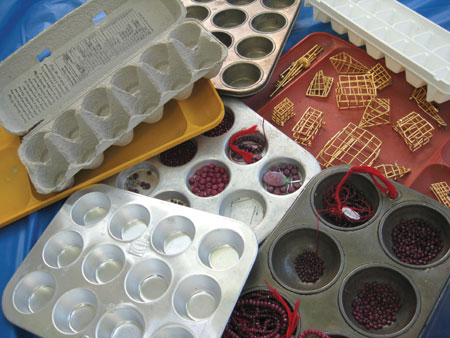Organize Bench Workflow with Trays
There are numerous mass production processes that bench jewelers can adapt and use to streamline their studio jewelry work. One of the organizational approaches used in factories is keeping parts in velvet-lined trays and moving them from one tray to the next as they progress through the manufacturing process. Keeping parts separated by manufacturing step helps workers to understand the process, exercise repeated quality control at every stage, and feel a rewarding sense of accomplishment as pieces progress.
2 Minute Read
There are numerous mass production processes that bench jewelers can adapt and use to streamline their studio jewelry work. One of the organizational approaches used in factories is keeping parts in velvet-lined trays and moving them from one tray to the next as they progress through the manufacturing process.
Keeping parts separated by manufacturing step helps workers to understand the process, exercise repeated quality control at every stage, and feel a rewarding sense of accomplishment as pieces progress.
A number of bench jewelers with whom I spoke when researching an upcoming book have found interesting ways of using trays in their studio work. Their ideas might inspire you to adopt this production-line mentality in your shop.
Tracking Trays
Susan Conta of Anacortes, Washington, uses a dental lab approach to her tray organization system. In her shop, all of the parts for a piece and a card listing design specs, part details, metal calculations and weight, as well as a work time log, stay on one tray throughout the evolution of a piece. "This helps immensely with the organizational pro-cess," she says. "It aids continuity. It makes information [about the piece] instantly available, as well as the time spent on individual processes." All pertinent information gets added to the card as you work on the piece, resulting in a useful time log for pricing and job history.
Cookie Trays
Many jewelers are fans of cookie trays because they are large, flat, low-rimmed, inexpensive, and can take heat. Hratch Babikian of Philadel-phia prefers the 18 inch by 24 inch industrial cookie sheets for use in his bench pan. "I just exchange them when changing the metal I am using in the day or on a job, so as not to waste time cleaning the pan," he says.
Photo Developing Trays
Rene Roberts of Little River, California, purchases plastic photo developing trays in various sizes and uses them to keep project-specific parts and supplies together. "When I need to take a brief break from one project to work on something else, everything from the first project can be moved in its tray to a corner of the bench," she says. "It's a great way to keep multi-media organized and the bench free of clutter."
Roberts also uses the trays to spread wet tumbling media so she can pick out small metal pieces after tumbling. "I move the tray out of the way until the media dries," she says. "The big lip allows pouring media back into the cans when it's dry."
Trays with Small Cells
"Ice cube trays make great organizers for little things," says Alison Flanders of London. Egg cartons are the tray of choice at Chris Ploof Studio in Pawtucket, Rhode Island, where Ploof uses the cartons to keep production parts in order.
The award-winning Journal is published monthly by MJSA, the trade association for professional jewelry makers, designers, and related suppliers. It offers design ideas, fabrication and production techniques, bench tips, business and marketing insights, and trend and technology updates—the information crucial for business success. “More than other publications, MJSA Journal is oriented toward people like me: those trying to earn a living by designing and making jewelry,” says Jim Binnion of James Binnion Metal Arts.
Click here to read our latest articles
Click here to get a FREE four-month trial subscription.
You assume all responsibility and risk for the use of the safety resources available on or through this web page. The International Gem Society LLC does not assume any liability for the materials, information and opinions provided on, or available through, this web page. No advice or information provided by this website shall create any warranty. Reliance on such advice, information or the content of this web page is solely at your own risk, including without limitation any safety guidelines, resources or precautions, or any other information related to safety that may be available on or through this web page. The International Gem Society LLC disclaims any liability for injury, death or damages resulting from the use thereof.
Charles Lewton-Brain
Master goldsmith Charles Lewton-Brain trained, studied and worked in Germany, Canada and the United States to learn the skills he uses. Charles Lewton-Brain is one of the original creators of Ganoksin.
The All-In-One Jewelry Making Solution At Your Fingertips
When you join the Ganoksin community, you get the tools you need to take your work to the next level.
Trusted Jewelry Making Information & Techniques
Sign up to receive the latest articles, techniques, and inspirations with our free newsletter.



